Kyoritsu KEW 1030 Handleiding
Kyoritsu
Multimeter
KEW 1030
Bekijk gratis de handleiding van Kyoritsu KEW 1030 (1 pagina’s), behorend tot de categorie Multimeter. Deze gids werd als nuttig beoordeeld door 61 mensen en kreeg gemiddeld 4.5 sterren uit 31 reviews. Heb je een vraag over Kyoritsu KEW 1030 of wil je andere gebruikers van dit product iets vragen? Stel een vraag
Pagina 1/1

○ Read through the following safety instructions contained in this
manual before using the instrument.
#DANGER
◦
Never make measurement on a circuit in which electrical potential to ground over
600V exists.
◦
Do not attempt to make measurement in the presence of flammable gasses.
Otherwise, the use of the instrument may cause sparking, which can lead to an
explosion.
◦
Never attempt to use the instrument if its surface or your hand is wet. Otherwise,
you may get electrical shock.
◦Never open the Bottom case and Battery cover during a measurement.
◦Do not exceed the maximum allowable input of any measuring range.
◦ Never try to make measurement if any abnomal conditions, such as broken
case is noted.
◦ The instrument should be used only in its intended applications or conditions
Otherwise, safety functions equipped with the instrument do not work, and
instrument damage or serious personal injury may be caused.
◦ Verify proper operation on a known source before use or taking action as a
result indication of the instrument.
◦ Keep your fingers and hands behind the protective fingerguard during
measurement.
#WARNING
◦
Never attempt to make any measurement if any abnormal conditions, such as
broken case and exposed metal parts are present on the instrument or test lead.
◦
Do not install substitute parts or make any modification to the instrument. Return
the instrument to your local Kyoritsu distributor for repair or re-calibration.
◦ Do not turn the function switch with plugged in test leads connected to the circuit
under test.
◦Do not try to replace the batteries if the surface of the instrument is wet.
◦ Always switch off the instrument before opening the battery compartment cover
for battery replacement.
◦ Stop using the test lead if the outer jacket is damaged and the inner metal or color
jacket is exposed.
#CAUTION
◦
Always set the Function switch to the appropriate position before making
measurement.
◦
Do not expose the instrument to the direct sun, high temperatures and humidity
or dew.
◦
This instrument is designed for in-door use. It can be used under the temperature
between 0℃ and without impairing its safety characteristics.40℃
◦ This instrument doesn't have dust/water-proof construction. Do not use the
instrument in dusty area or where it easily gets wet. It may lead to failure of the
instrument.
◦
Be sure to set the function selector switch to the OFF" position after use. When “
the instrument will not be in use for a long period of time, place it in storage after
removing the battery.
◦ Use a damp cloth and detergent for cleaning the instrument. Do not use abrasives
or solvents.
○Measurement categories (Over-voltage categories)
To ensure safe operation of measuring instruments, IEC establishes safety 61010
standards for various electrical environments, categorized as O to CAT IV, and called
measurement categories. These are defined as indicated below.
Higher-numbered categories correspond to electrical environments with greater
momentary energy, so a measuring instrument designed for CAT environments Ⅲ
can endure greater momentary energy than one designed for CAT Ⅱ.
ⅡCAT : Primary electrical circuits of equipment connected to an AC electrical
outlet by a power cord.
ⅢCAT : Primary electrical circuits of the equipment connected directly to the
distribution panel, and feeders from the distribution panel to outlets.
Designed to meet CAT V when the cap and protective cover is attached to the Ⅲ600
test lead and to meet CAT V when the cap and protective cover is not attached Ⅱ 600
to the test lead.
2.Features
This instrument is a pen-type digital multimeter and can measure: AC/DC voltage,
resistance, capacitance and frequency/duty ratio. It also provides continuity check
and diode check functions.
◦Designed to meet the following safety standards.
IEC - measurement category (CAT) V61010 1 Ⅲ600
IEC - (for hand-held Probe assemblies)61010 031
◦
Double molded main body and Function switch provide comfortable single handed grip.
◦Penlight illuminates brightly the point to be measured.
◦Backlight LCD is highly visible, even in darkness.
◦REL function to check the difference (DC.V/ CAP).
◦Auto-power-off function to save battery.
◦Data hold function
◦All ranges including Ohm range are protected against overload voltage of 600V.
◦Test lead is wrapped in its rear side compartment without difficulty.
◦Test pin can be covered by a unique cover mechanism for safety.
INSTRUCTION MANUAL
KYORITSU ELECTRICAL INSTRUMENTS
WORKS, LTD.
PEN TYPE DIGITAL MULTIMETER
KEW 1030
1.Safety warnings #
○ This instrument has been designed, manufactured and tested according to IEC
61010: Safety requirements for Electronic Measuring apparatus, and delivered in
the best condition after passed the inspection.
This instruction manual contains warnings and safety rules
which must be observed by the user to ensure safe operation
of the instrument and retain it in safe condition. Therefore, read
through these operating instructions before using the instrument.
#WARNING
◦ Read through and understand the instructions contained in this manual before
using the instrument.
◦
Save and keep the manual at hand to enable quick reference whenever necessary.
◦The instrument is to be used only in its intended applications.
◦ Understand and follow all the safety instructions contained in the manual.
◦ The RESPONSIBLE BODY shall be made aware that, if the equipment is used
in a manner not specified by the manufacturer, the protection provided by the
equipment may be impaired.
Failure to follow the instructions may cause injury, instrument damage and/or
damage to equipment under test. Kyoritsu is by no means liable for any damage
resulting from the instrument in contradiction to this cautionary note.
○ The symbol
#indicated on the instrument means that the user must refer to the
related parts in the manual for safe operation of the instrument.
Be sure to carefully read the instructions following each
#symbol in the manual.
#DANGER : is reserved for conditions and actions that are likely to cause
serious or fatal injury.
#WARNING: is reserved for conditions and actions that can cause serious
or fatal injury.
#CAUTION : is reserved for conditions and actions that can cause injury or
instrument damage.
○ Please refer to following explanation of the symbols used on the instrument
and in this manual.
# User must refer to the explanations in the instruction manual.
Instrument with double or reinforced insulation
〜 AC
DC
This instrument satisfies the marking requirement defined in the WEEE Directive
( /2002 96/EC). This symbol indicates separate collection for electrical and electronic
equipment.
3.Specification
Note:
Following abbreviations are used in above table.
◦
rdg is an abbreviation of "reading", and it means the indicated value at a
measurement.
◦ dgt is an abbreviation of "digit", and it means the figure to be displayed at the
rightmost digit.
◦ Ω(* ): Except for M1 40 range at Ohm function.
◦
(*2): At Voltage function, the Auto-ranging function is released by pressing the
SELECT key. To measure a voltage again, turn the Function switch to the "OFF"
position once. Then set it to the Voltage function again.
3−2 General specification
◦ △ΣMethod of operation : method
◦Display : Liquid crystal display (max. counts)/Units/ Marks3999
◦Over-range indication : "OL" displayed when exceeding the measuring range.
(except for AC/DC V range)600
◦Range switching : Fully-automatic range
( Single range is available at Continuity, Diode check and
DUTY range.)
Range shifts to upper range: counts or more.4000
Range shifts to lower range:less than counts.360
◦Sample rate : twice per second
◦ ΩFunctional construction : OFF/ ACV/ DCV/ / Capacitance
◦Key : HOLD/ Hz/ DUTY/ /
/
REL (only at DCV and Capacitance ranges)Δ
◦Power source : Button type battery LR (SR ) . V x 44 44 1 5 2
◦Low battery warning : " " mark is displayed at . V . V or less.2 4 ±0 2
◦Dimension : 190 39 31(L) x (W) x (D)mm
◦Weight : Approx. g (including batteries)100
◦Location for use : Altitude up to m, in-door use2000
◦Operating temperature : 0 40 85〜℃, relative humidity % or less
& humidity range (no condensation)
◦Storage temperature : - , relative humidity % or less20 60〜℃85
& humidity range (no condensation)
◦Accessories : Carrying case x 1
Button type battery LR ( . V) x 44 1 5 2
Instruction manual x 1
◦Standards (Safety) : IEC/EN - , IEC/EN - -・61010 1 61010 2 033
Measurement category (CAT) VⅢ600
Pollution degree 2
IEC/EN -・61010 031
EN (EMC) EN (RoHS)・61326 ・50581
3−3 Electrical characteristics
◦ ℃ ℃Temperature & : 23 ±5 , relative humidity % or less 85
humidity range (no condensation)
(guaranteed accuracy)
◦Supply voltage range : . V till the "3 4 " mark is displayed.
(guaranteed accuracy)
◦ ΩInsulation resistance : M10 or more/ DC V1000
(between electrical circuit and case enclosure)
◦Withstand voltage : AC Vrms, sine wave ( / Hz for sec.)5158 50 60 5
(between electrical circuit and case enclosure)
◦Overload protection : V (AC/DC) for sec. at voltage function720 10
(Over-voltage protection) V (AC/DC) for sec. at all functions600 10
other than voltage function
◦Rated supply voltage : DC . V3 0
◦Rated power : Approx. mVA (when battery voltage is . V)4 3 0
◦Max. rated power : Approx. mVA (when lights are on)30
◦Continuous operating : Approx. hours (DCV measurement)80
time
Approx. for 15 hours (A operation; turning the light on
10 20 sec. and off for sec., is repeated.)
4.Instrument layout
4-1 Instrument layout
③
①
②⑤
④ ⑥ ⑦ ⑧ ⑨
⑩
①Test pin (input terminal (+); red)
②Test lead (input terminal (
-
); black)
:Connected to the negative (
-
) side or the earth of the circuit.
③ Protective cover
:Covering the Test pin for safety purpose.
④ Penlight
⑤ Protective fingerguard
: It is a part providing protection against electrical shock and ensuring the
minimum required air and creepage distances.
⑥ Function switch
■ OFF Power off (Battery will not be wasted.):
■ AC voltage (ACV) Frequency (Hz) DUTY(%)
Switches by pressing the "SELECT" key.
■ DC voltage (DCV) REL (relative value display)Δ
Switches by pressing the "SELECT" key.
■ Ω Resistance Diode check
Continuity check
Switches by pressing the "SELECT" key.
■ Capacitance REL (relative value)Δ
Switches by pressing the "SELECT" key.
■ LIGHT:Turning on the Penlight. Set the Function switch to this position first,
and then turn it to any desirable function position. Then the Penlight turned
on and illuminates the test point. (Measurement cannot be performed in this
switch position.)
⑦ HOLD key
・Freezing the indicated value.
・ Turning on the LCD backlight. (Press this key at least 2 sec.)
⑧ SELECT key
(・Switching the measurement modes. / Hz/ DUTY and / /Ω
)
Δ・Enable/ Disable the REL function. (Only at DCV/ Capacitance)
⑨ LCD indication Low battery warning
Auto-ranging
DC
AC
Polarity
Hold
Diode check
Continuity check
RELΔ
Unit
}
⑩ Cap:Test leads can be used under the CAT II and CAT III environments by
attaching a protective cap as illustrated below. Use of our protective cap offers
different lengths suitable for the test environments.
When the instrument and the test lead are combined and used together,
whichever lower category either of them belongs to will be applied.
4-2 Protective cover
#CAUTION
◦
Do not apply excessive force to the Test pin and the Protective cover.
◦
Be careful not get hurt by the tip of the Test pin when setting or releasing the
Protective cover.
◦
Designed to meet CAT III V when the cap is attached to the test lead and to 600
meet CAT II V when the cap is not attached to the test lead.600
Use the Protective cover to cover the Test pin when carrying or storing the
instrument.
1Method of setting the Protective cover
Pinch the tip of the Protective cover, and pull it towards the tip direction.
Then turn it degrees as shown in the figure below to match the marks on the 90
cover and on the instrument body.
Set ReleaseCAT Ⅲ
2Method of releasing the Protective cover
Pinch the tip of the Protective cover, and pull it towards the tip direction.
Then turn it degrees as shown in the above figure. Then the cover is 90 stored
automatically and the Test pin (positive terminal) appears.
6−1 AC voltage(ACV), Frequency and DUTY ratio measurement
1Set the Function switch to" "position.
2
Connect the Test pin and test lead to AC circuit as shown in the figure below to
measure AC voltage (ACV).
3
Press the SELECT key and select the Frequency range to measure a frequency.
In this case, the unit " " is displayed on the LCD.Hz
◦Following measurements can be done
by pressing the SELECT key.
ACV Frequency DUTY ratio
4
Press the SELECT key and select the DUTY ratio range to measure a DUTY ratio
(Pulse width/ Pulse cycle). In this case, the unit " " is displayed on the LCD.%
Note
◦
At ACV function, a few dgts may remain displayed on the LCD after removing the
input.
◦
Connect the test lead (minus terminal) to the earth side of the circuit under test.
When the circuit under test does not have the earth, any connection is allowed.
◦
At Frequency and DUTY ratio measurement, the measurable min. input is approx.
1 5. Vrms.
6−2 DC voltage(DCV) measurement
1
Set the Function switch to" "position.
2
Connect the Test pin to the positive (+) side of the equipment under test and the test
lead to the negative (
-
) side as shown in the figure below. When test lead is
connected to the positive (+) side, the "-" mark is displayed on the LCD.
3Press the SELECT key to display a REL value (relative value).
Press this key and store the initial measured value. After that, the difference between
the stored value and the measured value is displayed on the LCD. Auto-ranging
function doesn't activate when this function is enabled. The first selected range will
be held. The relative measurement is allowed in the following range.
-* Measuring range = Full scale value at a range initial value
Press this key again or switch the measurement function to others to release the REL
function.
◦Following measurements can be done
by pressing the SELECT key.
DCV RELΔ (relative value)
" " mark is displayed△
on the LCD.
6−3 Resistance ( Ω ) measurement, Diode/ Continuity check
1Set the Function switch to" "position.Ω
2
Connect the Test pin and test lead to the equipment under test as shown in the
figure below.
DISTRIBUTOR
Kyoritsu reserves the rights to change specifications or designs desscribed in this manual
without notice and without obligationss.
8-18 92-1634H
4−3 Method of storing the test lead
Test lead is stored in the rear side compartment of the instrument.
Cord is winded around the cord holder.
5.Functions
◦Auto-ranging (AUTO)
A function to automatically select the appropriate measurement range based on
the input signal. The "
AUTO
" mark is displayed on the LCD while this function is
activated. This function is not available in Diode check, Continuity check and Duty
ratio measurements. The "
AUTO
" mark is not displayed.
◦Hold function ( )
A function to freeze the measured value on the LCD. (Not available in Frequency
measurement)
The " " mark is displayed on the LCD when the HOLD key is pressed.
Then the measured value is frozen. Press this key again or switch the
measurement function to others to release the Hold function.
◦REL function ( )Δ
A function to display the difference between the measured values (relative value)
on the LCD at DCV and Capacitance functions. The " " mark is displayed on the Δ
LCD when the HOLD key is pressed. Then the value being measured is stored.
After that, the difference between the stored value and the measured value is
displayed on the LCD. Press this key again or switch the measurement function to
others to release the REL function.
◦Auto-power-off function
A function to turn off the instrument when min. have elapsed after the Function 30
switch is switched from OFF to the other measurement function.
Press the HOLD key again or switch the measurement function to others to
restore from the Auto-power-off state.
◦Over-range indication
When the measured value exceeds the max. indication range, "
OL
" is displayed
on the LCD. (This indication is not displayed at AC/DC V range.) This 600
indication is not displayed while the Hold function is activated.
◦Low battery warning ( )
When the battery voltage drops to 2 4. V±0 2. V or less, the " " mark is displayed
on the LCD.
◦Penlight
Set the Function switch to "LIGHT" position
to turn on the Penlight. Turn the switch to
a n y d e si r a b l e f u n c t i o n p o si t i o n .
(Measurement cannot be performed when
the switch is in "LIGHT" position.) Turn the
switch to "OFF" position to turn off the light.
①Penlight ON
②Select any
function to make
measurement
Measurement function
③Penlight
OFF
◦LCD backlight
The LCD backlight lights up by pressing down the HOLD key at any measurement
function other than OFF at least sec.. 2
Press down this key again at least sec. or turn the Function switch to OFF once to 2
turn off the light.
Note
◦
Penlight and LCD backlight are not turned off automatically. Be sure to turn them off
when they are not in use.
◦
When turning on/ off the LCD backlight, the " " mark is displayed on the LCD and
the Hold function is activated. Press the HOLD button for a while to release the
function and perform the next measurement.
6.Measurement
#DANGER
To prevent electrical shock to person and damage to the instrument, following
instructions must be observed.
◦
The max. rated voltage to ground is AC/DC V. Never attempt to make measurement 600
on a circuit in which electrical potential to the ground exceeding this voltage exists.
◦
The max. input voltage is DC Vrms (sin). Never attempt to make any 600 600V/AC
measurement on a circuit in which electrical potential exceeding this voltage exists.
◦
Do not operate the Function switch during a measurement.
◦
Never make a measurement with the Bottom case is removed.
◦
Keep your fingers and hand behind the barrier (see 4 1- ) of the instrument and test lead.
◦
Be careful not to short-circuit the line under test with the metal part of the instrument
or the test lead during a measurement.
◦
Never make measurement on an energized circuit at Resistance, Diode check,
Continuity check and Capacitance function of this instrument.
◦Always attach the cap firmly when using the test lead under CAT environment. Ⅲ
When the test lead is connected to the instrument, the lower category either of
them
belongs to is applied.
◦
Keep your fingers and hands behind the protective fingerguard during
measurement.
3 Press the SELECT key to conduct the Diode check.
Connect the Test pin and the test lead to the equipment under
test. When following indication is confirmed, the diode is good.
◦Following measurements can be done
by pressing the SELECT key.
Ω Diode check Continuity check
1.Forward direction 2.Backward direction
Cathode CathodeAnode Anode
(Example)
Forward voltage
is displayed.
(Example)
"OL"
is displayed.
Note
◦
When the forward voltage of diode is out of the range of 0 3. V〜1.5V,
measurement may not be done. (Zener diode, LED and etc.)
4
Press the SELECT key to conduct the Continuity check. Connect the
Test pin and the test lead to the equipment under test.
Buzzer sounds when continuity is ok. ( or less)120Ω
Resistance value of or less is displayed on the LCD.400Ω
Note
◦
Indicated value may not be " " after shorting the tip of the test lead. 0
However, this is because of the resistance of the test lead and not a failure.
6−4 Capacitance measurement(nF , μF)
1
Set the Function switch to " " position.
2Press the SELECT key to make the indicated value to " " before 0
connecting the test lead to the equipment under test.
◦
Press the SELECT key to make the indication
to .0
3 Connect the Test pin and the test lead to the equipment under test as shown in the
figure below.
Note
◦
Measuring time varies depending on the capacitance to be measured.
Capacitance
to be measured < < <4μF 40 μF 100 μF
Measuring
time 2 7 sec. sec. 15 sec.
7.Battery replacement
#WARNING
◦
To avoid getting electrical shock, be sure to remove the measuring terminals from
the equipment under test; set the Function switch to OFF position before replacing
batteries.
#DANGER
◦
Do not mix new and old batteries. Never mix the different kinds of batteries.
◦
Make sure to install batteries in correct polarity as marked inside.
◦
Be sure to fasten the Battery case-fixing screws after the battery replacement.
#CAUTION
◦
Dispose the used batteries according to the rules, which are defined by each
community.
① Set the Function switch to OFF position.
② Loosen one Battery cover-fixing screw, and remove the Battery cover.
③ Replace the batteries with new ones. Make sure to install batteries in correct polarity
as marked inside. Always replace all two batteries with new ones at the same time.
④ Put the Battery case at the original position, and fasten the screws.
Battery cover-fixing screw
Button type battery
LR44(SR44) 1.5V×2pcs
8.Maintenance
◦
Cleaning
Use a cloth dipped in water or neutral detergent for cleaning the instrument.
Do not use abrasives or solvents. Otherwise, instrument get damaged,deformed
or discolored.
Continuity
Check
50nF
500nF
5uF
50uF
100uF
5Hz
50Hz
500Hz
5kHz
50kHz
200kHz
3-1
Accuracy [ guaranteed at temperature & humidity: % RH(* ) ]23±5 45 85℃, 〜1
Function Range Accuracy
Max. input voltage
ACV
Auto-ranging(* )2
DCV
Auto-ranging(* )2
400mV
4V
40V
400V
600V
Ω
Auto-ranging
400 Ω
4kΩ
40kΩ
400kΩ
4MΩ
40MΩ
Diode check/
Continuity Check
Capacitance
Auto-ranging
Frequency
Auto-ranging
DUTY(pulsewidth/ pulse
cycle)
DC V600
AC Vrms(sin)600
0 1.〜99 9. %
± 2. %rdg5 ± 5dgt(Accuracy is
guaranteed up to kHz.)10
± 1. %rdg3 ± 5dgt ( / Hz)50 60
± 1. %rdg7 ± 5dgt ( Hz)〜400
± 1. %rdg6 ± 5dgt ( / Hz)50 60
± 2. %rdg0 ± 5dgt
( Hz)〜400
± 0. %rdg8 ± 5dgt
± 1. %rdg0 ± 5dgt
± 1. %rdg0 ± 5dgt
± 2. %rdg5 ± 5dgt
Diode check
Test voltage:approx. . V . V0 3 〜1 5
Buzzer sounds when
resistance is or less.120 Ω
± 3. %rdg dgt5 ± 10
± 4. %rdg5 ± 5dgt
± 3. %rdg5 ± 5dgt
± 0. %rdg1 ± 5dgt
Measurable input:
1 5. Vrms or more
4V
40V
400V
600V
Product specificaties
| Merk: | Kyoritsu |
| Categorie: | Multimeter |
| Model: | KEW 1030 |
Heb je hulp nodig?
Als je hulp nodig hebt met Kyoritsu KEW 1030 stel dan hieronder een vraag en andere gebruikers zullen je antwoorden
Handleiding Multimeter Kyoritsu

1 December 2024

1 December 2024

1 December 2024

5 Januari 2024

5 Januari 2024

5 Januari 2024

5 Januari 2024

5 Januari 2024

4 Januari 2024

4 Januari 2024
Handleiding Multimeter
- Uni-T
- Chauvin Arnoux
- Tacklife
- Schneider
- Greenlee
- REV
- Testboy
- Hubinont
- Appa
- Klein Tools
- Monacor
- MGL Avionics
- Yato
- Digi-tool
- Keithley
Nieuwste handleidingen voor Multimeter

15 Juli 2025
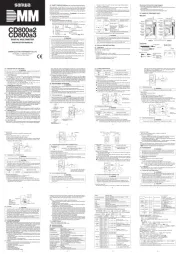
22 Juni 2025
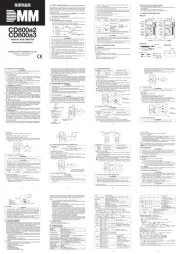
22 Juni 2025
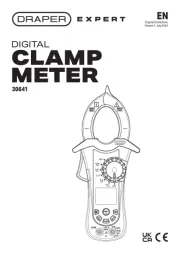
7 Juni 2025
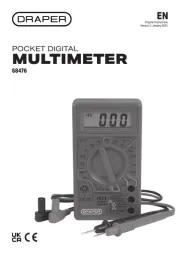
4 Juni 2025
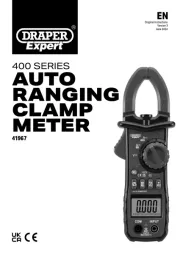
3 Juni 2025
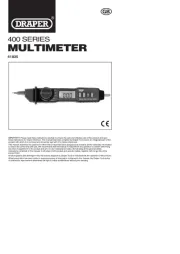
2 Juni 2025
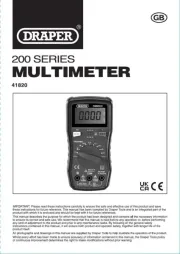
30 Mei 2025
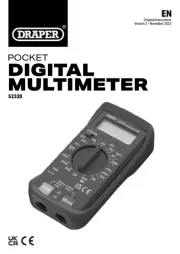
30 Mei 2025
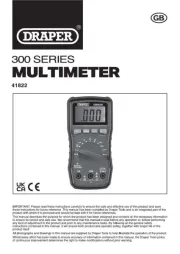
30 Mei 2025